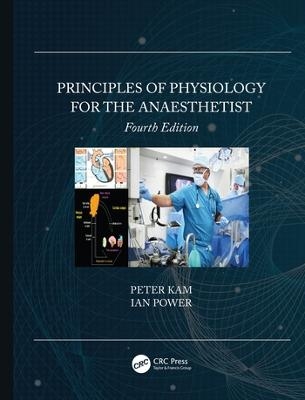
Principles of Physiology for the Anaesthetist
CRC Press (Verlag)
978-0-367-25512-1 (ISBN)
Peter Kam MBBS, MD, FRCA, FANCZA, FFARCSI, FHKCA (Hon) Nuffield Professor of Anaesthetics, Sydney Medical School, University of Sydney Royal Prince Alfred Hospital Camperdown, Australia Ian Power BSc (Hon), MD, FRCA, FFPMANZCA, FANZCA, FRCSEd, FRCP Edin, FFPFRCA Emeritus Professor at the University of Edinburgh, Edinburgh, United Kingdom
Preface to the first edition. Preface to the second edition. Preface to the third edition. Preface to fourth edition. Acknowledgements. Authors. Contributors. Basic Cell Physiology. Cell Components and Function. Physiology of Excitable Cells. Neurotransmitters and Receptors, Ion Channels, G Proteins and Second Messengers. Physiology of the Nervous System. Neuronal Function. Blood–Brain Barrier and Cerebrospinal Fluid (CSF). Cerebral Circulation. Spinal Cord: Anatomical and Physiological Features. Sensory System. Motor Function and Control: Descending Tracts. Autonomic Nervous System. Consciousness, EEG, Sleep and Emotions. Muscle Physiology. Striated Muscles: Skeletal and Cardiac Muscles. Muscle Spindles, Golgi Tendon Organs and Spinal Reflexes. Smooth Muscle. Respiratory Physiology. Functions of the Respiratory System. Mechanical Properties of the Lungs. Gas Exchange in the Lungs. Carriage of Oxygen in Blood. Carbon Dioxide Carriage in Blood. Pulmonary Circulation. Control of Ventilation. Applied Respiratory Physiology. Cardiovascular Physiology. Functions of the Cardiovascular System. Electrical Properties of the Heart. Mechanical Events of the Cardiac Cycle. Pressure–Volume Loop of the Left Ventricle. Physical Factors Governing Blood Flow Through Vessels. The Systemic Circulation. Microcirculation. Venous Return and Vascular Function. Regulation of Arterial Blood Pressure. Integrated Cardiovascular Responses. Gastrointestinal Physiology. Saliva, Swallowing, and Lower Oesophageal Sphincter. Stomach: Gastric Secretions, Motility, Digestion and Vomiting. The Small Intestine: Secretions, Digestion and Motility. The Large Intestine. Liver Physiology. Functions of the Liver. Liver Blood Flow. Liver Function Tests and Physiological Features of Liver Failure. Renal Physiology. Functions of the Kidneys and Functional Anatomy. Renal Blood Flow. Glomerular Filtration. Tubular Function. The Loop of Henle and Production of Concentrated Urine: Counter-Current Mechanisms of the Kidney. Overview of Renal Control of Acid–Base Balance. Applied Physiology: Renal Failure. Acid–Base Physiology. Basic Concepts of Acid–Base Physiology. Compensatory Mechanisms in Acid–Base Disorders. Clinical Aspects of Acid–Base Control. Anion Gap and Stewart’s Strong Ion Difference. Physiology of Blood. Cellular Components of Blood. Plasma: The Non-Cellular Components of Blood. Haemostasis. Blood Transfusion. Physiology of the Immune System. Immune System and Innate Immunity. Acquired Immunity. Cytokines. Hypersensitivity. Endocrine Physiology. General Aspects of Endocrine Physiology. Pituitary Gland. Hormones of the Pancreas. Thyroid Hormones and Calcium Metabolism. Hormones of the Adrenal Gland. Erythropoietin, Atrial Natriuretic Peptide and Sex Hormones. Metabolism, Nutrition, Exercise and Temperature Regulation. Metabolism. Nutrition. Exercise Physiology. Temperature Regulation. Physiology of Pain. Peripheral Mechanisms of Pain. Central Modulation of Pain. Pain Sensitization. Physiology of Pregnancy, Placenta, Neonate, Ageing and Obesity. Physiology of Pregnancy. Physiology of the Placenta. Physiology of the Neonate. Physiology of Ageing. Physiology of Obesity. Special Environments. Physiology Related to Special Environments. Further reading. Index.
| Erscheinungsdatum | 11.05.2020 |
|---|---|
| Zusatzinfo | 75 Tables, black and white; 383 Line drawings, color |
| Verlagsort | London |
| Sprache | englisch |
| Maße | 189 x 246 mm |
| Gewicht | 1420 g |
| Themenwelt | Medizin / Pharmazie ► Allgemeines / Lexika |
| Medizin / Pharmazie ► Medizinische Fachgebiete ► Anästhesie | |
| Studium ► 1. Studienabschnitt (Vorklinik) ► Anatomie / Neuroanatomie | |
| Studium ► 1. Studienabschnitt (Vorklinik) ► Physiologie | |
| ISBN-10 | 0-367-25512-X / 036725512X |
| ISBN-13 | 978-0-367-25512-1 / 9780367255121 |
| Zustand | Neuware |
| Haben Sie eine Frage zum Produkt? |
aus dem Bereich


